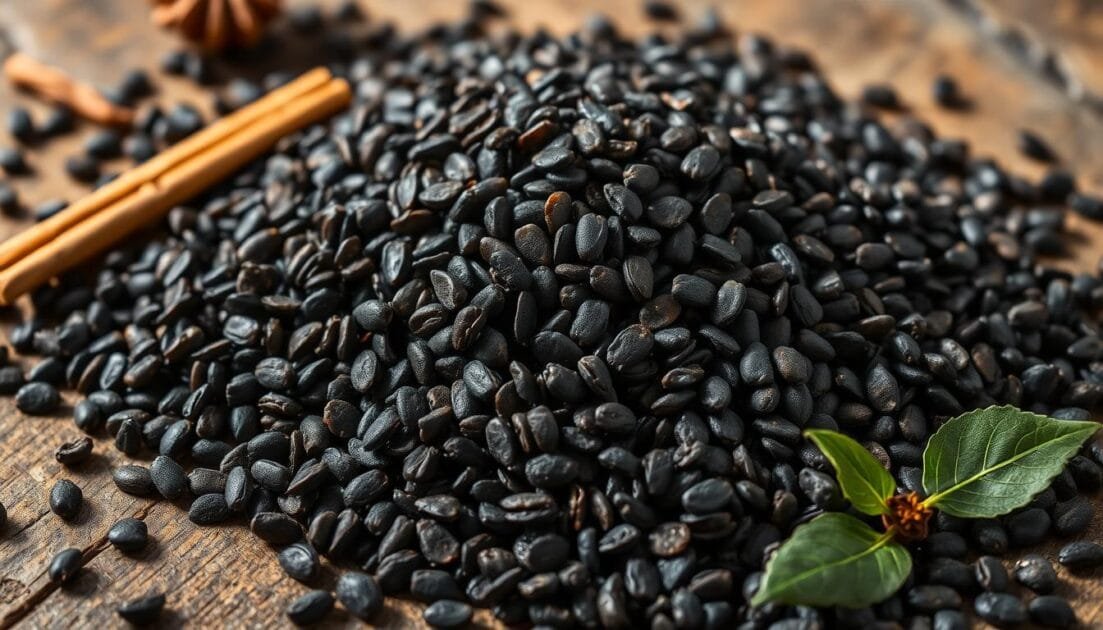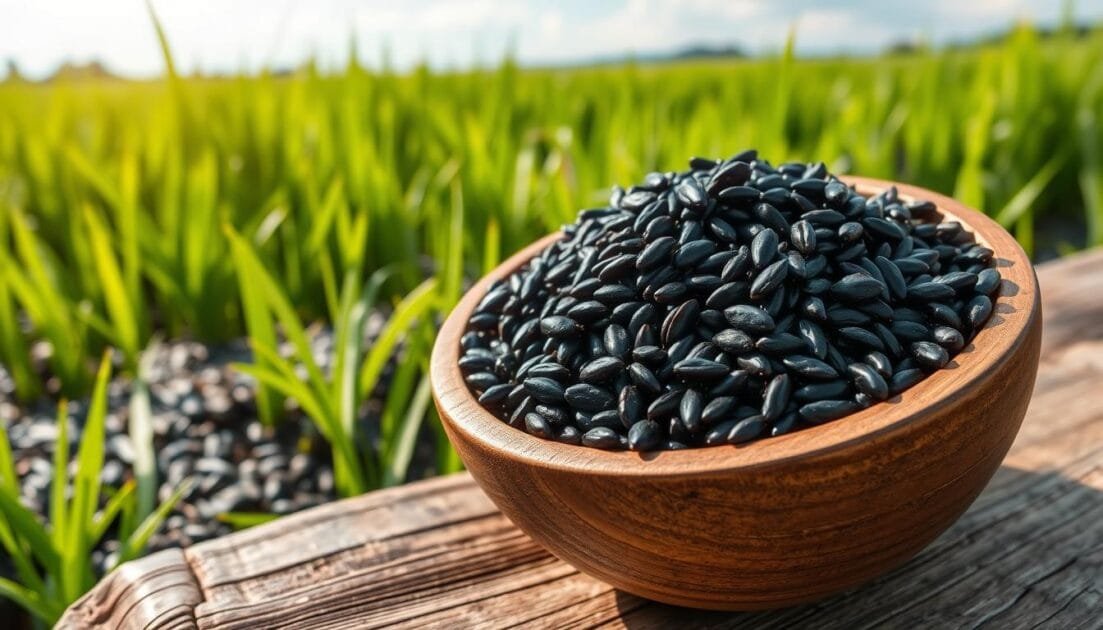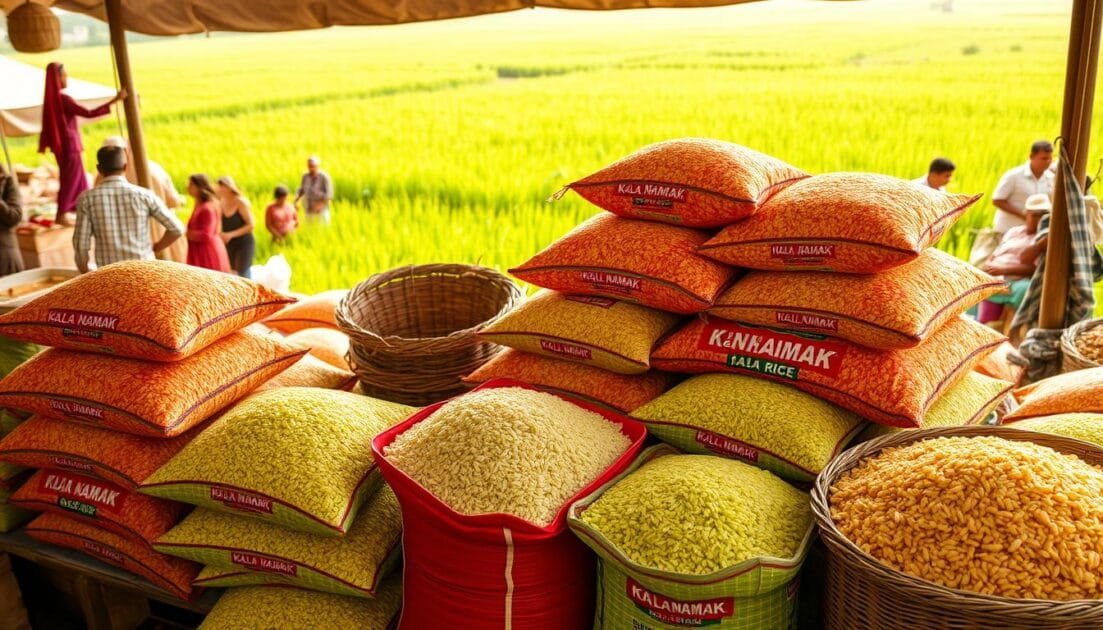Table of Contents[Hide][Show]
- The Distinctive Black Color and Aromatic Properties
- Cooking Characteristics of Kalanamak Rice
- Market Value and Economic Impact
- Authentication and Quality Standards
- Modern Applications in Cuisine
- Conclusion
FAQ+−
- What are the properties of Kalanamak rice?
- What is the historical significance of Kalanamak rice?
- What gives Kalanamak rice its distinctive black color and aroma?
- What are the nutritional benefits of Kalanamak rice?
- How does Kalanamak rice perform in the cooking process?
- What are the cultivation requirements for Kalanamak rice?
- What is the market value and economic impact of Kalanamak rice?
- How does Kalanamak rice compare to other premium rice varieties?
- How can consumers ensure the authenticity of Kalanamak rice?
- What are the optimal storage conditions and shelf life for Kalanamak rice?
- How is Kalanamak rice being used in modern cuisine?
Kalanamak rice, also known as “Buddha’s Rice” or “Black Rice,” is a special heirloom variety. It has been grown in the Indian state of Uttar Pradesh for centuries. This premium grain is known for its black color, enticing aroma, and great nutritional value.
It has deep roots in ancient Buddhist culture. Kalanamak rice is highly valued for its spiritual and culinary importance. It is a beloved staple in the region.

Key Takeaways
- Kalanamak rice is an heirloom variety with a distinctive black color and aromatic profile.
- It has been cultivated in Uttar Pradesh, India for centuries, with deep cultural and historical significance.
- Kalanamak rice is highly prized for its exceptional nutritional composition and health benefits.
- This premium heritage grain is recognized for its unique cooking characteristics and versatility in cuisine.
- Kalanamak rice is an important part of India’s agricultural heritage and has a growing economic impact.
Understanding the Ancient Origins of Kalanamak Rice
Kalanamak rice, also known as “Buddha’s gift,” has a long history. It comes from the ancient Indian subcontinent. This rice is special because of its connection to Buddhism, making it loved by many.
Historical Significance in Buddhist Culture
Kalanamak rice is deeply rooted in Buddhism. It’s said Lord Buddha loved this rice during his teachings. This rice is key in Buddhist ceremonies, standing for purity and enlightenment.
Geographic Origins and Traditional Growing Regions
Kalanamak rice grows mainly in Uttar Pradesh and Bihar, India. These places have the right climate and soil for it. They are also close to Buddhist traditions.
The special soil and old farming ways help keep Kalanamak rice unique. It has a black color and a strong smell. This makes it a big part of local culture and life.
“Kalanamak rice is not just a food, but a testament to the enduring connection between the Buddhist faith and the land that nourishes it.”
The Distinctive Black Color and Aromatic Properties
Kalanamak rice, also known as buddha rice, is famous for its black color and enticing smell. It stands out from white or brown rice with its dark color and fragrant scent.
The black color of Kalanamak rice comes from anthocyanins, natural plant compounds. These pigments make the rice look unique and offer health benefits. They are full of antioxidants.
Kalanamak rice also has a special smell that makes it different. Its scent comes from aromatic compounds, like those found in basmati rice. This is what gives it its unique fragrance.
The black color and the enticing smell of Kalanamak rice make it unforgettable. It’s a favorite in traditional Indian and Buddhist cooking.
“Kalanamak rice is a true gem, a culinary delight that captivates the senses with its striking appearance and enticing fragrance.”
Nutritional Composition and Health Benefits
Kalanamak rice, also known as “Buddha rice,” is a unique and ancient rice variety. It has a deep black color and is packed with vitamins, minerals, and antioxidants. This makes it a standout choice for those looking for a nutritious food.
Essential Minerals and Vitamins
Kalanamak rice is rich in iron, magnesium, and zinc. These minerals are key for health, boosting the immune system, and helping make red blood cells. It also has B-complex vitamins like thiamine, niacin, and vitamin B6. These vitamins are important for energy and nerve function.
Antioxidant Properties
Kalanamak rice is known for its high antioxidant levels. The black color comes from anthocyanins, which fight off harmful free radicals. This can help lower the risk of chronic diseases and adds to its unique taste and smell.
Dietary Fiber Content
Kalanamak rice is also high in dietary fiber. This fiber is good for digestion, blood sugar control, and gut health. With its mix of nutrients, antioxidants, and fiber, it’s a great addition to a healthy diet.
“The exceptional nutritional profile of kalanamak rice sets it apart as a true superfood among rice varieties.”
Cooking Characteristics of Kalanamak Rice
Kalanamak rice, also known as Buddha rice, is a unique and ancient variety. It has a captivating black color and an aromatic profile. This makes it a sought-after ingredient in Indian cuisine.
The texture of Kalanamak rice is delicate and fluffy. Its grains are slightly shorter and more rounded than regular long-grain varieties. When cooked, the rice absorbs water well, becoming tender and moist.
The cooking time for Kalanamak rice is a bit longer than standard basmati rice. It takes about 20 to 25 minutes to cook. Use a 1:2 rice-to-water ratio and fluff the rice gently with a fork after cooking.
When cooked right, Kalanamak rice shows a captivating black hue. This adds visual appeal to any dish. The rice’s unique pigmentation, from anthocyanins, also offers health benefits as a natural antioxidant.
“The intriguing black color and alluring aroma of Kalanamak rice make it a true delight for the senses.”
Adding Kalanamak rice to your dishes can enhance the experience. It adds depth, complexity, and a touch of tradition. Whether it’s a fragrant biryani, a hearty pulao, or a simple side dish, this rice is sure to impress.

Production Methods and Cultivation Requirements
Growing kalanamak rice, also known as “Buddha rice,” needs careful attention to soil and climate. This special rice grows best in eastern Uttar Pradesh and nearby. Here, the right mix of temperature, rain, and soil makes it black and aromatic.
Soil Conditions and Climate Needs
The kalanamak rice plant likes well-drained, slightly acidic soil with lots of organic matter. It grows best in a pH of 6.0 to 6.5 and a temperature of 20-30°C (68-86°F). It needs 1,000 to 1,500 mm of rain a year, mostly during the monsoon.
Harvesting Techniques
- The kalanamak rice is harvested in late October or early November. The grains are fully mature, and the leaves are golden-brown.
- Harvesting is done by hand with sickles, then the grains are separated from the chaff.
- The grains are dried in the sun to keep their unique aroma and texture.
The careful way kalanamak rice is grown and harvested makes it rare and valuable. It’s highly sought after worldwide.
Market Value and Economic Impact
Kalanamak rice, also known as “Buddha rice,” is a top choice in the premium rice market. It costs more than other rice types. This is because of its unique taste, smell, and cultural importance.
Its price is between ₹80 to ₹120 per kilogram. This is higher than the ₹40 to ₹60 for regular rice. The high price shows its quality and the hard work that goes into growing it.
| Rice Variety | Average Retail Price (per kg) |
|---|---|
| Kalanamak (Buddha Rice) | ₹80 – ₹120 |
| Basmati Rice | ₹60 – ₹100 |
| Regular Long Grain Rice | ₹40 – ₹60 |
Kalanamak rice’s impact goes beyond its price. It helps many small farmers in Uttar Pradesh’s Terai region. It also boosts the local economy.
More people want this rice, which means more jobs and money for farmers. It also leads to more research and efforts to keep this special rice alive.
As more people learn about and enjoy traditional foods, kalanamak rice will likely become even more valuable. This will help both those who grow it and those who love to eat it.

Comparison with Other Premium Rice Varieties
Kalanamak rice, also known as “buddha rice,” has a unique taste. It’s different from jasmine or basmati rice. Kalanamak rice has a strong, earthy smell and a nutty flavor.
Taste Profile Differences
The taste of kalanamak rice comes from how it’s grown and the climate. Unlike other premium rices, kalanamak rice has a bold, savory taste. This makes it stand out for those who want a deeper rice flavor.
Price Point Analysis
Kalanamak rice is pricier than other premium rices. This is because it’s harder to grow and farm. But, its quality, taste, and cultural value make it worth the extra cost.
“The rich, earthy taste of kalanamak rice is a truly unique culinary experience that sets it apart from the more common rice varieties.”
Even though kalanamak rice costs more, it’s loved by food lovers. Its connection to Buddhist culture also boosts its appeal in the premium rice market.
Authentication and Quality Standards
In the world of premium rice, kalanamak rice is known for its unique flavor and black color. To ensure it’s genuine, strong checks are in place. These steps keep the rice’s quality and value high, especially for its buddha rice price.
Finding real kalanamak rice means looking at its size and color. The grains should be small to medium and black. The smell should be nutty and slightly sweet. If the rice doesn’t match these, it’s not the real deal.
- Examine the rice grains closely for their characteristic black color and small to medium size.
- Inhale the aroma, looking for the distinctive nutty and earthy notes.
- Ensure the price point aligns with the premium status of kalanamak rice.
Keeping kalanamak rice quality high is a team effort. Farmers, processors, and regulators work together. They follow strict rules to avoid mixing it with other rice. Tests check the rice’s size, color, and smell to make sure it’s up to standard.
“Preserving the authenticity of kalanamak rice is essential to safeguarding its cultural heritage and ensuring consumers receive the exceptional product they expect.”
By sticking to these standards, kalanamak rice‘s special status is protected. This lets fans of the rice enjoy it for years to come.
Storage Requirements and Shelf Life
Keeping kalanamak rice, also known as “Buddha rice,” fresh is key. This ancient grain is loved for its black color and strong smell. It needs special care to stay great over time.
Optimal Storage Conditions
To keep kalanamak rice fresh, store it in a cool, dry, dark place. Heat, humidity, or light can ruin its taste and texture. The best storage temperature is between 50°F and 70°F, with humidity under 65%.
Preservation Methods
There are ways to make kalanamak rice last longer:
- Airtight Containers: Use airtight, food-grade containers or jars to keep moisture out and keep it fresh.
- Vacuum Sealing: Vacuum sealing removes air, protecting the rice from damage.
- Cold Storage: Refrigeration or freezing below 40°F can extend its life. But, avoid moisture from temperature changes.
Stored right, kalanamak rice can stay fresh for up to 12 months. Always check for spoilage like color changes, bad smells, or pests. Eat it within the suggested time frame.
| Storage Condition | Shelf Life |
|---|---|
| Room Temperature | 6-9 months |
| Refrigerated | 9-12 months |
| Frozen | 12-18 months |
Following these storage tips and methods helps keep kalanamak rice fresh. This way, you can enjoy its unique flavor, smell, and health benefits for a long time.
Modern Applications in Cuisine
More and more chefs and home cooks are finding new ways to use kalanamak rice. Known as “Buddha rice,” it’s now part of many different dishes. This rice variety is becoming a hit in modern cooking.
Kalanamak rice is being used in fancy rice bowls and risottos. Its black color and smell make these dishes special. Chefs mix it with many flavors, showing how versatile it is.
Kalanamak rice is also used in unique sushi and desserts. It adds a special taste to sushi and is healthier in sweet dishes like puddings and mochi.
| Dish | Kalanamak Rice Application | Average Price (INR) |
|---|---|---|
| Kalanamak Rice Bowl | Cooked kalanamak rice served with sautéed vegetables, grilled protein, and garnishes | 250-350 |
| Kalanamak Rice Risotto | Creamy kalanamak rice risotto with seasonal vegetables and herbs | 350-450 |
| Kalanamak Rice Sushi | Sushi rolls made with kalanamak rice, fresh seafood, and traditional garnishes | 500-700 |
| Kalanamak Rice Pudding | Sweet, creamy kalanamak rice pudding with aromatic spices and dried fruits | 150-250 |
The world of cooking is loving kalanamak rice more and more. We’ll see even more creative dishes using this special grain.
Conclusion
Kalanamak rice, also known as “Buddha rice,” is a fascinating heritage variety. It has stood the test of time. This ancient grain is deeply rooted in India’s rich cultural history.
Its black color and unique aroma make it a favorite in Indian cooking. It adds a special touch to many dishes. Kalanamak rice is also packed with nutrients, including minerals, vitamins, and antioxidants. These help keep us healthy and strong.
Exploring Kalanamak rice reveals its deep connection to Buddhist culture. It was seen as a sacred offering. Its ability to grow well in tough conditions makes it a valuable crop for sustainable farming in India.
FAQ
What are the properties of Kalanamak rice?
Kalanamak rice, also known as “Buddha’s gift,” is a premium heritage rice from India. It has a black color and a strong aroma. This sets it apart from other rice types. It has a rich history and is important in Buddhist traditions.
What is the historical significance of Kalanamak rice?
Kalanamak rice is deeply rooted in Buddhist culture. It was a staple food during Buddha’s time, earning it the name “Buddha’s gift.” Its growing regions are tied to the origins of Buddhist teachings in India.
What gives Kalanamak rice its distinctive black color and aroma?
Kalanamak rice’s black color and aroma come from genetics and environment. Its unique look and smell are highly valued. This makes it a premium heritage grain.
What are the nutritional benefits of Kalanamak rice?
Kalanamak rice is packed with nutrients like minerals, vitamins, and antioxidants. It has more iron, zinc, and magnesium than other rice types. It’s also high in dietary fiber, making it a healthy choice.
How does Kalanamak rice perform in the cooking process?
Kalanamak rice cooks differently than other varieties. It takes a bit longer to cook but results in a flavorful dish. This showcases its premium qualities.
What are the cultivation requirements for Kalanamak rice?
Kalanamak rice needs specific soil and climate conditions. It grows best in well-drained, fertile soil and a moderate, humid climate. Local farmers use traditional methods to keep the rice quality high.
What is the market value and economic impact of Kalanamak rice?
Kalanamak rice is expensive due to its quality and limited supply. It helps local communities and the Indian agriculture sector. This is because of its preservation and promotion.
How does Kalanamak rice compare to other premium rice varieties?
Kalanamak rice has a unique taste and aroma. Its higher price is worth it for its quality and cultural value. It’s a sought-after specialty grain.
How can consumers ensure the authenticity of Kalanamak rice?
It’s important to buy genuine Kalanamak rice. Look for certified sources. This ensures the rice meets quality standards and preservation methods.
What are the optimal storage conditions and shelf life for Kalanamak rice?
Kalanamak rice needs cool, dry, and airtight storage. This keeps it fresh and preserves its quality. Proper storage is key to its shelf life.
How is Kalanamak rice being used in modern cuisine?
Kalanamak rice is used in modern dishes by chefs and home cooks. Its versatility and flavor make it a favorite in both traditional and new recipes. This shows its cultural significance and premium status.

 Buy Premium Kalanamak Rice | Price And Quality Guide
Buy Premium Kalanamak Rice | Price And Quality Guide